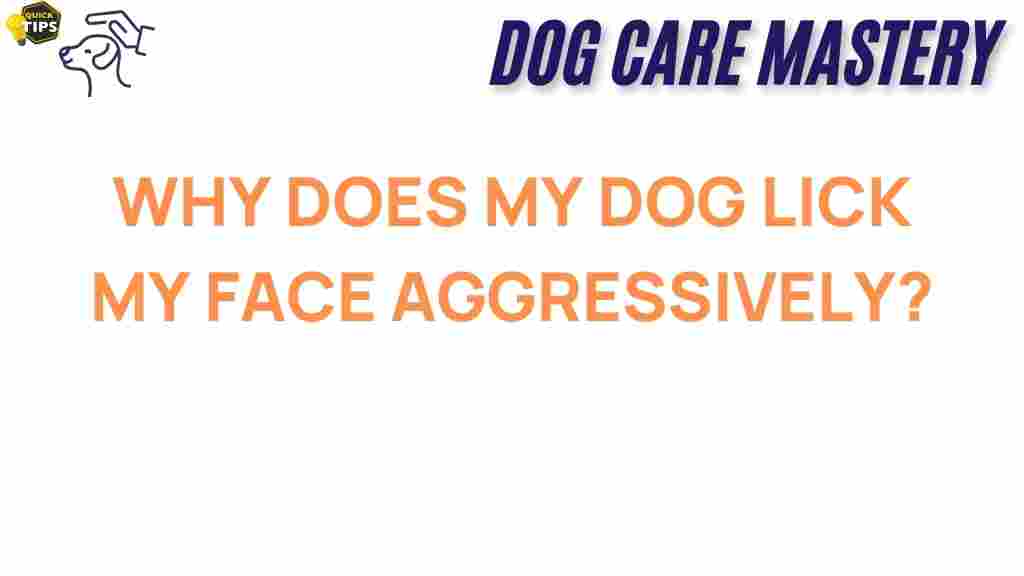Understanding Dog Behavior: The Surprising Reasons Behind Your Dog’s Aggressive Face Licking
Many dog owners have experienced the peculiar phenomenon of their pets engaging in aggressive face licking. While it may seem like a playful gesture, it can sometimes signal underlying issues related to dog behavior. Understanding why your dog behaves this way is crucial for fostering a harmonious relationship between you and your furry friend. This article explores the surprising reasons behind this behavior, offering insight into canine psychology and practical solutions for managing it.
What Is Face Licking in Dogs?
Face licking is a common behavior among dogs and can manifest in various ways. It may appear as gentle licking or more aggressive, almost frantic licking. While dogs often lick their human companions as a sign of affection, aggressive face licking can indicate something more complex. Here are some factors that might contribute to this behavior:
- Communication: Dogs communicate primarily through body language and physical gestures. Licking can signal submission, affection, or even a request for attention.
- Grooming Behavior: Dogs lick to groom themselves and others. It can be a part of their social bonding rituals.
- Exploration: Dogs explore their environment through their mouths. Licking your face might be a way for them to learn about you.
- Anxiety or Stress: In some cases, aggressive licking can be a sign of anxiety or stress, manifesting in ways that may seem aggressive.
Why Does Your Dog Exhibit Aggressive Face Licking?
Understanding the reasons behind your dog’s aggressive face licking can shed light on their behavior and help you address any underlying issues. Here are some surprising reasons:
1. Attention-Seeking Behavior
Dogs are naturally social animals and often seek attention from their owners. If your dog notices that aggressive licking gets a reaction from you, whether positive or negative, they may repeat this behavior. Consider the following:
- If you react strongly, your dog might see this as a cue to continue licking.
- Positive reinforcement, such as petting or treats, can inadvertently encourage this behavior.
2. Stress or Anxiety
Just like humans, dogs can experience stress and anxiety. Aggressive licking may be a coping mechanism when they feel overwhelmed or nervous. Signs of stress in dogs can include:
- Panting or drooling
- Excessive barking
- Destructive behavior
- Withdrawal or hiding
Identifying stressors in your dog’s environment can help mitigate this behavior. Consider consulting with a veterinarian or a dog behaviorist for tailored advice.
3. Medical Conditions
In some cases, aggressive face licking may stem from medical issues. Dogs may lick their owner’s face if they themselves are in discomfort or pain. Some potential medical conditions include:
- Dental issues or oral pain
- Skin allergies or irritations
- Gastrointestinal problems
If you suspect that your dog’s behavior is related to a medical condition, it’s essential to seek veterinary advice promptly.
4. Instinctual Behavior
Dogs have instincts that drive their behavior. In the wild, licking is a part of pack behavior. It can be a way for dogs to show submission or reinforce social bonds. If your dog licks your face aggressively, it might be an instinctual behavior that they have inherited from their ancestors.
Managing Aggressive Face Licking
Now that you understand why your dog may be licking your face aggressively, it’s time to address the behavior. Here are some steps to help you manage it:
Step 1: Observe and Identify Triggers
Take note of the situations that lead to aggressive face licking. Is it when guests arrive, during playtime, or when your dog is anxious? Understanding the context can help you address the root cause.
Step 2: Redirect the Behavior
If your dog begins to lick your face aggressively, redirect their attention to a toy or a treat. Encouraging them to engage in positive behavior can help decrease the licking.
Step 3: Reinforce Positive Behavior
When your dog refrains from aggressive licking, reward them with treats or praise. Positive reinforcement can help them associate good behavior with rewards.
Step 4: Establish Boundaries
Setting clear boundaries is essential. If face licking is not acceptable, calmly but firmly say “no” and redirect them to a more appropriate behavior. Consistency is key.
Step 5: Consult a Professional
If the behavior persists despite your efforts, consider seeking help from a professional dog trainer or behaviorist. They can provide personalized strategies tailored to your dog’s specific behavior.
Troubleshooting Tips
Here are some troubleshooting tips to help you manage your dog’s aggressive face licking behavior effectively:
- Consistency is Key: Ensure all family members enforce the same rules regarding licking.
- Provide Mental Stimulation: Engage your dog with puzzle toys and training exercises to reduce boredom.
- Practice Calmness: Remain calm and avoid yelling, as this can exacerbate anxiety in your dog.
- Monitor Health: Regular veterinary check-ups can help identify any underlying health issues that may contribute to the behavior.
Conclusion
Understanding your dog’s behavior is crucial to enhancing your relationship. Aggressive face licking can often be misunderstood, and it’s important to recognize the various reasons behind this behavior. From seeking attention to expressing anxiety or instinctual behaviors, identifying the root cause is essential for effective management.
By observing triggers, redirecting behavior, and reinforcing positive actions, you can effectively address aggressive face licking. If necessary, don’t hesitate to reach out to a professional for additional guidance. Remember, fostering a loving and understanding environment will contribute significantly to your dog’s overall well-being.
For more information on dog behavior and training, check out this helpful resource. If you’re looking for products that can help manage your dog’s behavior, consider visiting this site.
This article is in the category Behavior and created by dogcaremastery Team
